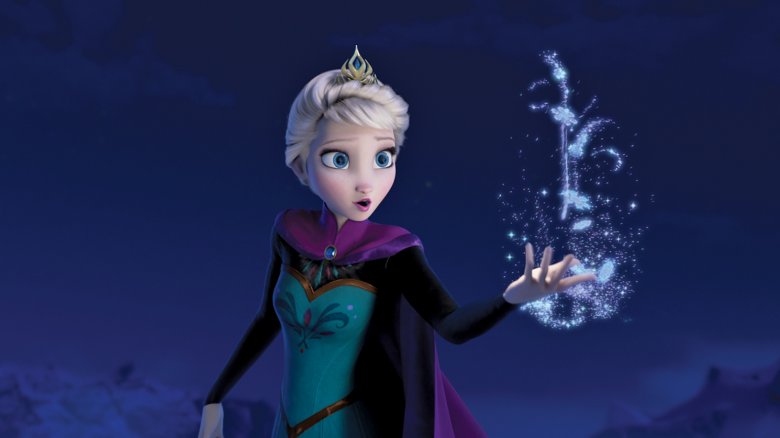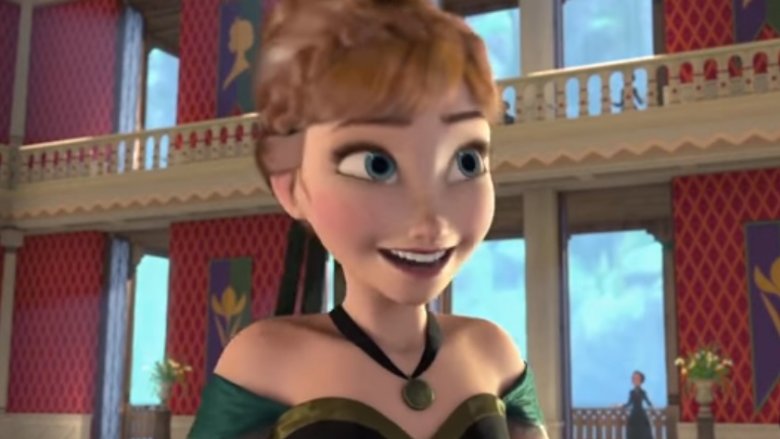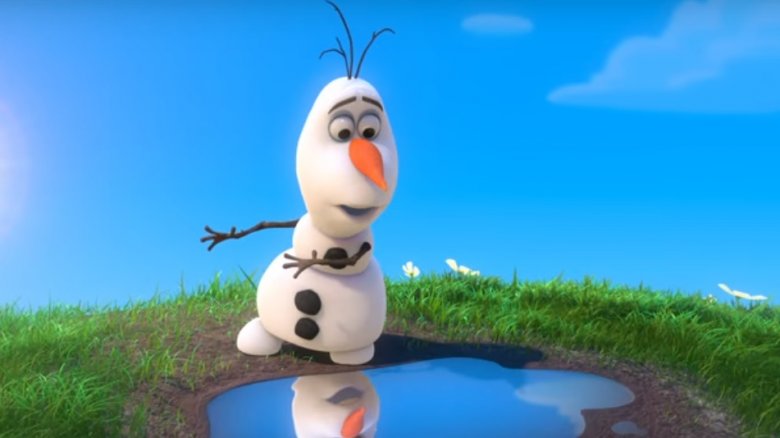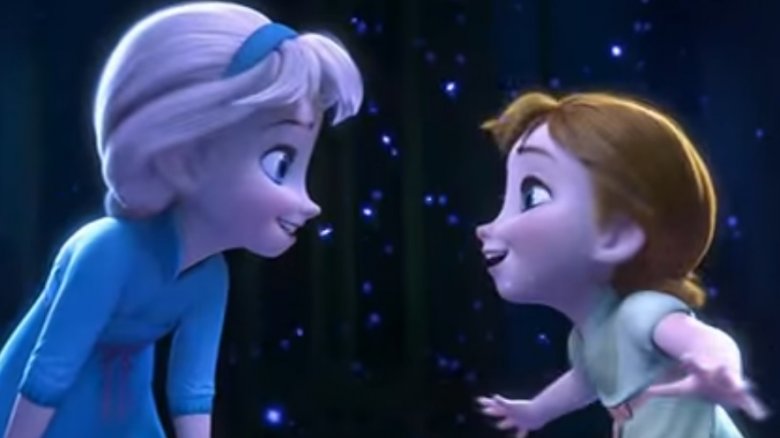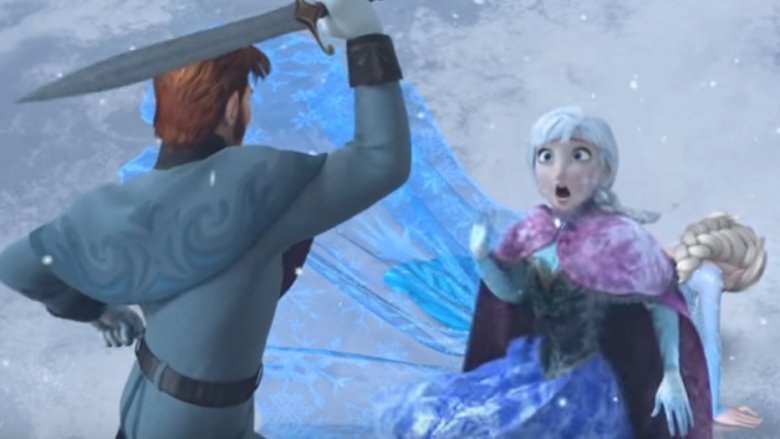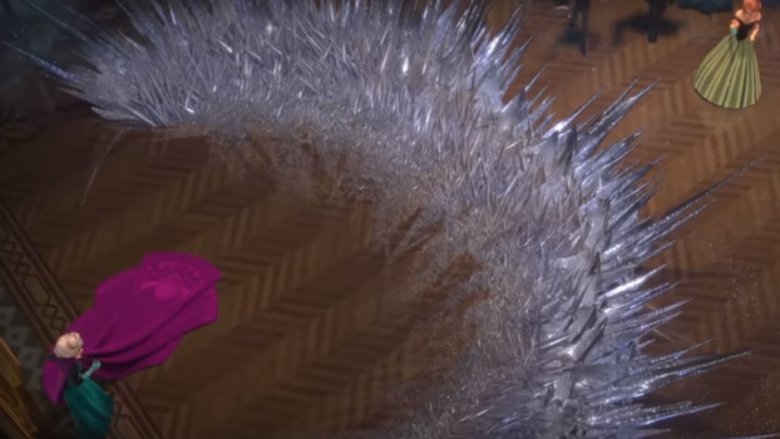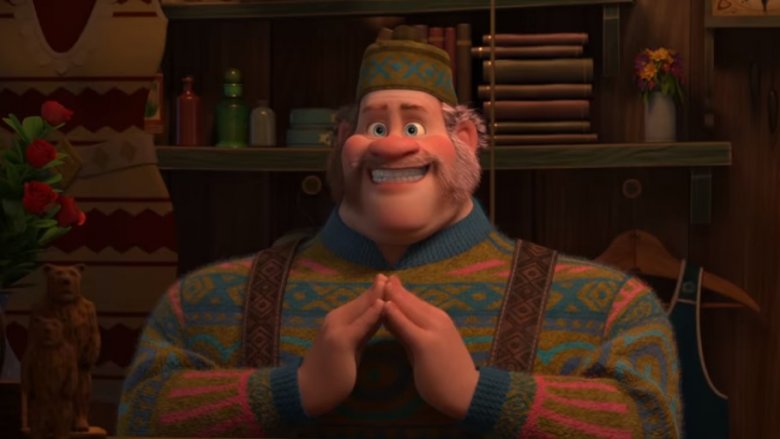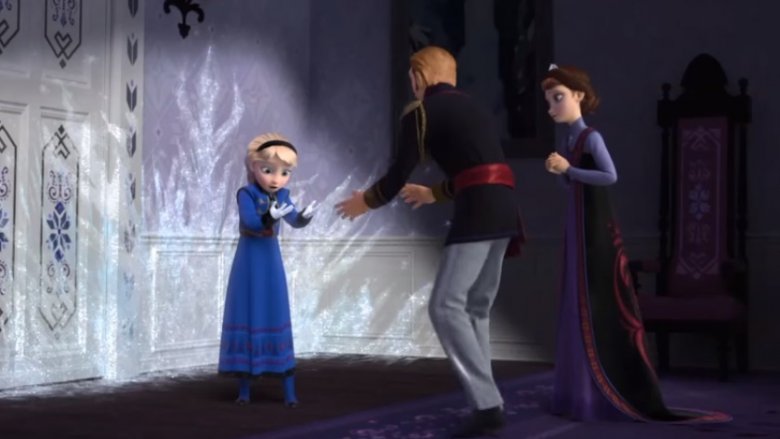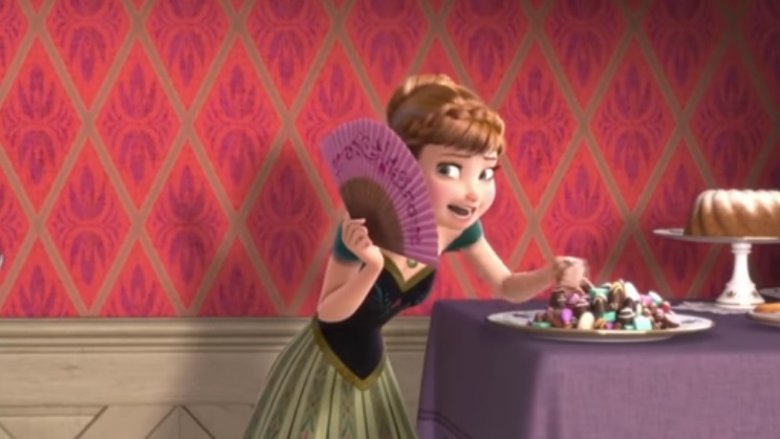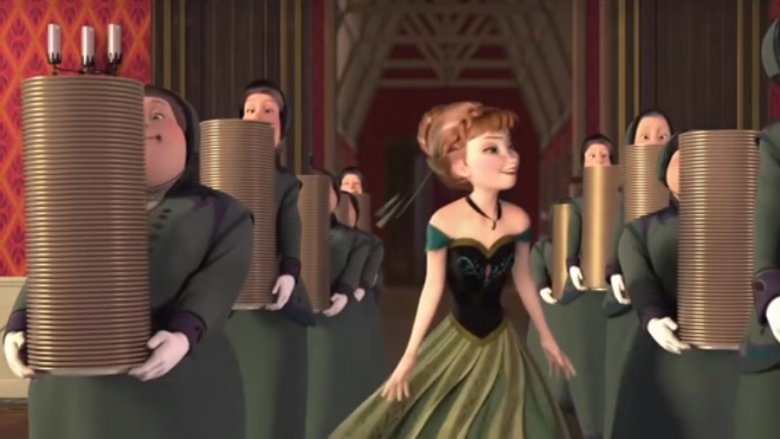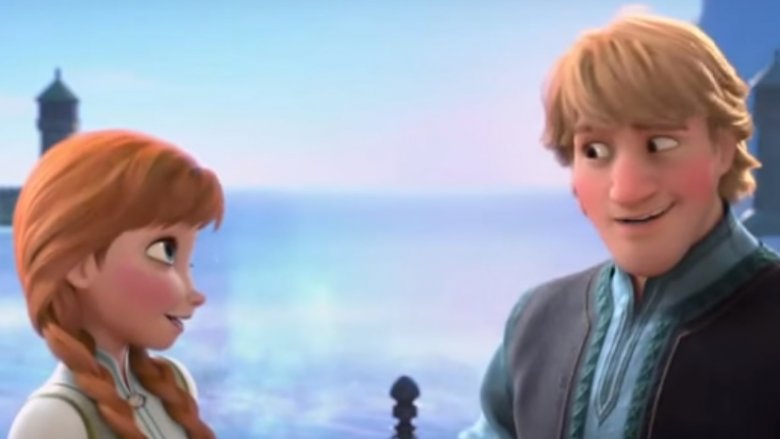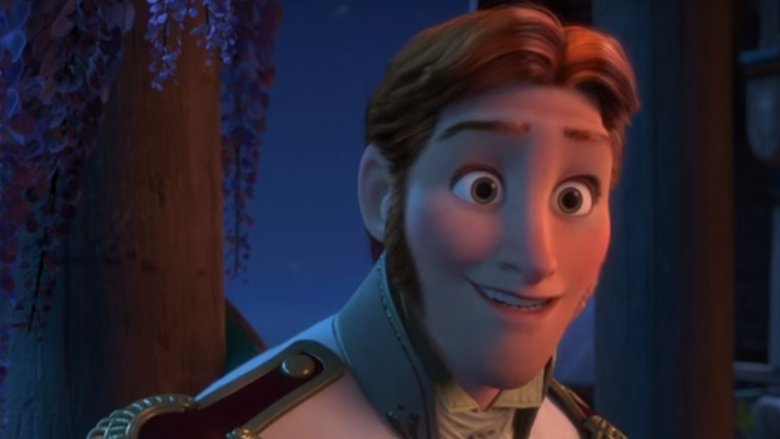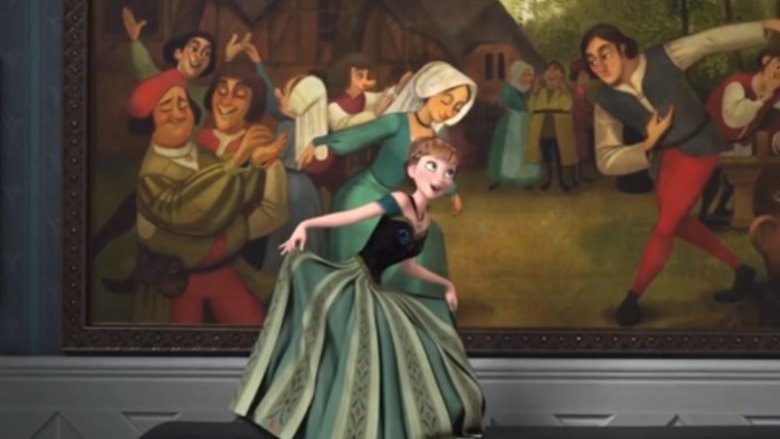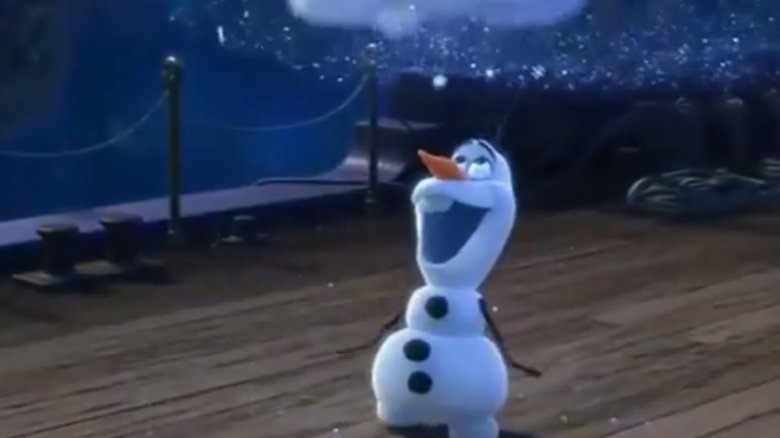Things In Frozen Only Adults Will Notice
Frozen is exceptionally popular among children and adults alike, and with good reason: the characters are developed, the dialogue is well-written, and the plot is full of fun and teachable moments. It debuted to receptive and enthusiastic audiences, and has since then become the highest-grossing animated film of all time.
That's no small task given that there is plenty of competition out there, from Finding Nemo to Despicable Me. But Frozen is a standout special for a lot of people, myself included, because of the way it not only subverts the dominant paradigm, but also because it makes you laugh, sing, and cry. Plus, there's a lot in the film that would go over most kids' heads, making it even more enjoyable for the parents. Here are some of the things you only notice about Frozen as an adult.
Anna made a dirty joke?
Blink and you'll miss it, but there are a few jokes that get the adults in the room laughing, leaving children puzzled as to why mom and dad are cracking up. For one, there's a line that Anna sings in For the First Time in Forever which could easily be taken as a double entendre; while dancing through the halls, she wonders, "Why have a ballroom with no balls?" Good question! Fortunately for Anna, the coronation is one of the biggest balls around, so her chances of finding true love are on the rise.
Olaf makes a dark joke implying his own death
It might not be a dirty joke, but there's a rhyme that smaller children might not catch when Olaf delivers the rousing In Summer.
"Winter's a good time to stay in and cuddle
But put me in summer and I'll be a — Happy snowman!"
We know they implied the word "puddle," which is what Olaf would be in summer. Too dark for the little ones, but the parents get it right away.
It passes the Bechdel Test in the first five minutes
Frozen passes the Bechdel Test in the first five minutes of the movie, which is quite the feat given that many films can't manage to pass it at all. Elsa and Anna are both named characters, and they talk about a variety of things in the movie, from playing in magic snow to their strained sisterly relationship. Additionally, they are the central relationship in the film, and the male characters like Hans and Kristoff are supporting characters, not leads. That's a big change from other Disney films, like Aladdin, which fails the Bechdel Test and denies Jasmine agency, or The Lion King, which arguably fails it as well with its dearth of female characters.
It puts sisters before misters
Anna is the real MVP of the film, who consistently puts her love for her sister above everything else, including her own safety on more than one occasion. That includes other people too, particularly her love interests, Hans and later, Kristoff.
First, she leaves Hans behind in Arendelle to look for her sister, refusing his company and assistance, instead asking him to stay behind. She treks out alone, putting herself at the mercy of the freezing woods — good thing she finds the trading post, or she might have frozen to death!
Then, when she sees that Hans is about to kill Elsa, she runs in front of his sword, saving her sister's life. And that willingness to die for her sister is the film's central act of true love, putting sisterhood above all else, which saves both of their lives. She even runs away from Kristoff to do it.
It's a metaphor for repressing feelings
Elsa's powers understandably scare her, as she can hurt the people she loves very badly if she doesn't keep them under strict control. And that fear is the driving force behind her decision to retreat from society and cut herself off from Anna, refusing to tell her why she won't see her anymore. Rather than confront her fears and deal with her feelings, she chooses to be alone, avoiding any potentially difficult situations.
But her absence has real consequences, namely that she hurts her sister just as badly by not being in her life. Also, she's hurting the people of Arendelle by imposing a premature winter upon the village. It's an apt metaphor for what happens when you refuse to confront your fears head on, and be vulnerable in front of others. It's only after she opens herself up again that things get better.
It's really white
Frozen is adorable. But it's also really, really white. The central characters are white, with pale skin and fair hair. The people of Arendelle are white, as are their trade partners from Weaselton. And predictably, the snowman is white. Yes, it's based on The Snow Queen by Hans Christian Anderson, a Danish author. Yes, it's set in Scandinavia. But there are people of color who live in Scandanavian countries, not just white people. In fact, the only characters who aren't recognizably white are the trolls, who some have argued are racially problematic.
Maybe Olaf wasn't just talking about the snow in Arendelle when he said, "It really is beautiful, but it's so white!"
Elsa has a huge cross to bear
Elsa has a lot on her shoulders for such a young kid. Imagine if you had to worry about accidentally hurting, or worse, killing the people you love with powers you never asked for, but are stuck with? Everyone from her parents to the head troll tell her that it's her responsibility to reign those powers in, too, and that her fear will only make things worse. But how are you supposed to not be afraid in that situation?
Additionally, she has to learn to control her powers alone, as her parents die after going on a trip that she begged them not to go on. And since it's not safe for her to be around Anna, she has to deal with everything on her own. That's some heavy stuff.
There's clearly no dieting in Arendelle
The women of Arendelle enjoy food. Anna leads the way, proclaiming that she wants to "stuff chocolate in my face," a sentiment plenty of folks can get behind. Additionally, Anna and Elsa express their mutual love for chocolate during the coronation party, sighing in unison about the pleasure of the smell of it alone. Then, when Anna and Hans ask Elsa for her blessing of their engagement, Anna rambles about the food they'll have at the wedding, like soup, roast, and ice cream — very important details! Then later, Anna chows down on a serious sandwich with Kristoff. It's refreshing to see a movie where young women aren't dieting or disordered in their eating.
There's body diversity in Arendelle
While Arendelle may be racially homogenous, there's still some other forms of diversity among the citizens. Namely, there are a variety of body sizes, ranging from thin to fat, which is great to see in a Disney film. Sure, there have been fat characters in Disney films before, like the motherly Mrs. Pots in Beauty and the Beast, and the fabulous and fierce Ursula in The Little Mermaid. And of course, there's Maui from Moana. But other than a small handful of characters, the general populaces of most Disney films did not deliberately showcase bodily diversity.
It encourages healthy romantic relationships
Anna is pretty head over heels for Hans when she approaches her sister for her blessing of their engagement. But Elsa is not buying that Anna has found true love just yet — after all, Anna and Hans have only known each other for one day. And Kristoff has a similar reaction when he learns that Anna and Hans only just met, asking her all kinds of questions to see how well she knows her new beau. Both Elsa and Hans are right in their assessment of the engagement, as many experts agree that you should date for about two years before you tie the knot.
This is a decidedly different tack from the romances of Disney past; in Cinderella, the prince wants to marry Cinderella after one night of dancing, even though he doesn't know her name. In The Little Mermaid, Ariel falls for Eric at first sight, later giving up her voice to be near him, and in the end leaves her entire ecosystem behind to marry him. And in Snow White, the princess has to lie dormant until she's rescued by a dude — not unlike Seeping Beauty. So the reaction we see by multiple characters in Frozen urging Anna against rushing into marriage is quite the improvement.
Hans is the very definition of toxic masculinity
It's a good thing that Anna didn't marry Hans out of the gate, given that it turned out he wasn't what he seemed to be. At first, he comes off as a stand-up dude, who's smart, funny, and sweet. He's willing to take care of Arendelle in Anna's absence, even though he abandons his post to find her when her horse comes back spooked — but he does it because he says he's worried.
He really seems the perfect guy, until he reveals that he's total con who just wants power, all too happy at the thought that Anna is in mortal danger. Hans is the very definition of toxic masculinity, who lies to Anna, drives a wedge between her and Elsa for his own selfish benefit, and is only interested in his own ambitions. He was even ready to murder Elsa without hesitation, something he would have gotten away with if not for Anna. So when Anna punches him, it's a satisfying moment of comeuppance for this toxic dude.
The paintings are based on real masterworks
The paintings that Anna dances in front of during For the First Time in Forever are clearly based on paintings by famous old masters, which made art history nerds everywhere rejoice. Some of the paintings that get a shout-out are The Peasant Dance by Bruegel the Elder, The Picnic by Auguste Serrure, El Jaleo by John Singer Sargent, and The Swing by Jean-Honoré Fragonard.
Additionally, the painting of Joan of Arc that Anna talks to during Do You Want to Build a Snowman could be inspired by a painting by Sir John Gilbert, as well as the statue of Joan of Arc in New Orleans, LA.
Olaf gets to live his best life
One of the sweetest things in Frozen is that in the end, Olaf's dream comes true, as impossible as it may seem. Because of Elsa's magical powers, Olaf can finally experience the joys of summertime, thanks to his own personal flurry that can keep him cold all year-round.
It's a metaphor for fitting in, even when you stick out like a sore thumb. As long as your friends have your back, you'll be okay anywhere, no matter how different you may be. So Olaf gets to live his best life, without fear of becoming a puddle.
